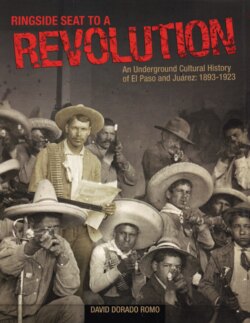Читать книгу Ringside Seat to a Revolution - David Dorado Romo - Страница 33
На сайте Литреса книга снята с продажи.
ОглавлениеFor eye infections Teresita used a homemade
mixture she applied to her patients’ eyes with drop-
pers. Samuel Franco, who was 12 years old when his
father took him to see Teresita while she was living
in South El Paso, recalled this method of treatment.
His eyes had been burning, red and inflamed for a
month before going to see her. He went to her for
four or five days and she would put drops of this mix-
ture in his eyes with a dropper. Franco told a historian
who interviewed him many years later that he never
had any problems with his eyes again after that until
he was 65 years old.38
Teresita sometimes used a
mixture of clay and saliva as oint-
ment. Her tongue would become
very dry and white when she made
this ointment, recalled Teresita’s
closest friend, Mariana Avendaño.
Teresita’s saliva would emit a
pleasant fragrance. “When she
would wash her feet, hands or her
face, the water she used to cleanse
herself would give off a beautiful
aroma and the people would col-
lect that water in their handker-
chiefs,” Avendaño remembered.
“One day Teresa said,
‘God is every-
where,’ and
touched the wall
and made a gesture
as if to throw some-
thing toward those who
were present. When she
did this the whole room
filled up with a wonderful
aroma.”39 People said that during
a healing Teresita smelled like roses.
Throughout her life the press asked
Teresita to explain her unusual powers. She admit-
ted that she wasn’t completely sure where they came
from. “I do not know. Theosophists say that some
astral body is making itself manifest through me; spir-
itualists say the spirit of some great and good person,
who has lived before me, is the source. Some doctors
say my powers are derived from purely physical or
nervous peculiarities,” she told a journalist. Teresita
rejected the label of saint that had been attached to
her. “I do not claim to have supernatural power, but
I have the wonderful will power and magnetism
strong enough to cure any and all diseases.”40
“When sick people come to me sometimes I can
see where they are sick just as if I was looking through
a window. Sometimes I cannot,” she explained during
other interviews.41 “I do not
know what it is. It came to me
without my knowledge and
when I was in a trance. It has
remained with me. I have cured
thousands, and I expect to cure
thousands more.”42
TERESITA’S FAME AS a
woman who possessed
special healing
powers began in
Sonora, Mexico,
seven years before
her sojourn in El
Paso. Teresita was
16 years old when
on October 20,
1889, she fell into
a coma.43 After
three and a half
months, she was
given up for dead.
A coffin was pre-
pared and a wake
was held for her. But she suddenly woke up
from her coma.
When Teresita opened her eyes, according
to some of the awestruck mourners at the wake,
she predicted that Huila would soon die and instruct-
ed her family to save the coffin. The Yaqui curandera
died that same week. Teresita stayed in a semi-trance
28
Teresita’s method of healing.
(New York Journal, March
3, 1901.)
38
Samuel Franco, interviewed by W. Holden, Jan. 15, 1962. Holden Collection, Texas Tech University.
39
La Opinión, March 7, 1937.
40
Tombstone Prospector, November 21, 1895.
41
San Francisco Examiner, July 27, 1900.
42
“Santa Teresa Journeying Around the World,” Copper Era, February 7, 1901.
43
There are different explanations for the cause of her coma. Historian José Valadés found evidence that she suffered a traumatic seizure in Cabora
after having been raped by a mining engineer named Millán, whose romantic advances Teresita had scorned. According to Mexico City newspaper
El Monitor Republicano, her convulsive attack was instead brought about by her discovery of Millán having sex with another woman. Others
believed she had overdosed on medicinal herbs—perhaps peyote—that she had been experimenting with as part of her apprenticeship with Huila.
Finally, there is evidence that Teresita was an epileptic and had suffered at least one other major seizure in 1886 after a virulent argument between
her mother and aunt. Lauro Aguirre, who wrote a biography of Teresita, believed her seizures were cataleptic, implying rigidity of the muscles,
rather than a nervous disorder.
